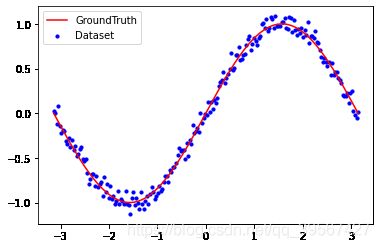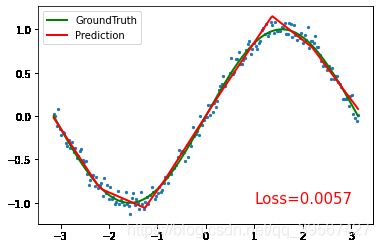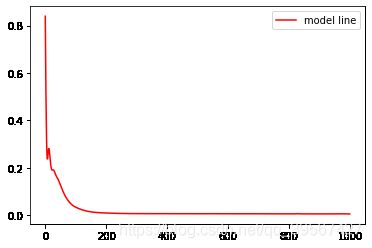Pytorch基础笔记 Ⅳ——单变量线性回归
文章目录
- 前情函数
-
- GPU相关语句
- torch.unsqueeze 与 torch.squeeze
- 正式开始
-
- 导入必要模块
- 构建数据集
- 模型定义
- 模型参数设置
前情函数
import torch
GPU相关语句
'''以下通过先判断GPU是否存在,
在通过对应的语句打印出GPU的信息
'''
if torch.cuda.is_available():
# 返回gpu数量
GPU_num = torch.cuda.device_count()
# 返回gpu名字,设备索引默认从0开始
GPU_name = torch.cuda.get_device_name(0)
# 返回当前设备索引
GPU_index = torch.cuda.current_device()
print(GPU_num, GPU_name, GPU_index)
else:
print('Use CPU for work')
1 GeForce GTX 960M 0
下面语句用于将模型放在GPU上训练
device = torch.device("cuda:0" if torch.cuda.is_available() else "cpu")
device
device(type='cuda', index=0)
torch.unsqueeze 与 torch.squeeze
torch.unsqueeze(input, dim) → Tensor
返回插入指定位置尺寸为1的新张量
返回的张量与此张量共享相同的基础数据
可以通过dim控制指定的轴向
这个函数主要是对数据维度进行扩充。给指定位置加上维数为1的维度
x0 = torch.tensor([1, 2, 3, 4])
print('x0 维度:', x0.size(),'\n', x0)
x1 = torch.unsqueeze(x0, 0)
print('x1 维度:', x1.size(),'\n', x1)
x2 = torch.unsqueeze(x0, 1)
print('x2 维度:', x2.size(),'\n', x2)
x0 维度: torch.Size([4])
tensor([1, 2, 3, 4])
x1 维度: torch.Size([1, 4])
tensor([[1, 2, 3, 4]])
x2 维度: torch.Size([4, 1])
tensor([[1],
[2],
[3],
[4]])
torch.squeeze(input, dim=None, out=None) → Tensor
移除输入张量维度为1的轴
例如输入张量的shape为: ( A × 1 × B × C × 1 × D ) (A \times 1 \times B \times C \times 1 \times D) (A×1×B×C×1×D)输出张量的shape则为: ( A × B × C × D ) (A \times B \times C \times D) (A×B×C×D)
可以通过dim控制指定的轴向,例如输入张量的shape为: ( A × 1 × B ) (A \times 1 \times B) (A×1×B),通过squeeze(input, 1),输出张量的shape为: ( A × B ) (A \times B) (A×B)
这个函数主要对数据的维度进行压缩,去掉维数为1的的维度
x0 = torch.zeros(2, 1, 2, 1, 2)
print('x0 维度:', x0.size())
x1 = torch.squeeze(x0)
print('x1 维度:', x1.size())
x2 = torch.squeeze(x0, 0)
print('x2 维度:', x2.size())
x3 = torch.squeeze(x0, 1)
print('x3 维度:', x3.size())
x0 维度: torch.Size([2, 1, 2, 1, 2])
x1 维度: torch.Size([2, 2, 2])
x2 维度: torch.Size([2, 1, 2, 1, 2])
x3 维度: torch.Size([2, 2, 1, 2])
正式开始
导入必要模块
安装pytorch时,不会安装torchsummary,需要手动通过!pip install torchsummary安装,如果不在jupyter中,则去掉感叹号进行安装
%matplotlib inline
import torch
from torchsummary import summary
import torch.nn.functional as F
import matplotlib.pyplot as plt
import pylab as pl
from IPython import display
torch.__version__
'1.6.0'
构建数据集
本案例中将以一个正弦函数 y = s i n ( x ) y=sin(x) y=sin(x)为例
如果使用多个GPU,应该使用torch.cuda.manual_seed_all()为所有的GPU设置种子。
if torch.cuda.is_available():
torch.cuda.manual_seed(1) #为当前GPU设置随机种子用于生成随机数,以使得结果是确定的
print('GPU is available')
else:
torch.manual_seed(1) #为CPU设置随机种子用于生成随机数,以使得结果是确定的
print('Use CPU for work')
GPU is available
squeeze是删除维度为1的轴,unsqueeze则是增加一个维度为1的轴,通过dim控制增加轴的方向,其中可以通过x.size()获取x的维度为torch.Size([100, 1])
import math
PI = math.pi
x = torch.unsqueeze(torch.linspace(-PI, PI, 200), dim=1)
y = torch.sin(x) + 0.07 * torch.randn(x.size())
plt.plot(x, torch.sin(x).numpy(), color='r', label='GroundTruth')
plt.scatter(x.numpy(), y.numpy(), s=10, color='b', label='Dataset')
plt.legend()
plt.show()
模型定义
采用relu激活函数,单隐层神经网络结构
class Net(torch.nn.Module):
def __init__(self, n_feature, n_hidden, n_output):
super(Net, self).__init__()
self.hidden = torch.nn.Linear(n_feature, n_hidden)
self.predict = torch.nn.Linear(n_hidden, n_output)
def forward(self, x):
x = F.relu(self.hidden(x))
x = self.predict(x)
return x
开启GPU模式并查看网络摘要summary
net = Net(n_feature=1, n_hidden=10, n_output=1).to(device)
summary(net, input_size=(1,))
----------------------------------------------------------------
Layer (type) Output Shape Param #
================================================================
Linear-1 [-1, 10] 20
Linear-2 [-1, 1] 11
================================================================
Total params: 31
Trainable params: 31
Non-trainable params: 0
----------------------------------------------------------------
Input size (MB): 0.00
Forward/backward pass size (MB): 0.00
Params size (MB): 0.00
Estimated Total Size (MB): 0.00
----------------------------------------------------------------
模型参数设置
优化器以及损失函数设置
optimizer = torch.optim.Adam(net.parameters(), lr=0.02)
loss_func = torch.nn.MSELoss()
将数据拷贝至GPU
x_data, y_data = x.to(device), y.to(device)
Pytorch参数重置,避免调参后重新运行for循环时,原始已训练参数进行保留
def weight_reset(m):
if isinstance(m, torch.nn.Conv2d) or isinstance(m, torch.nn.Linear):
m.reset_parameters()
%%time
net.apply(weight_reset)
loss_value = []
for i in range(1000):
prediction = net(x_data)
loss = loss_func(prediction, y_data)
optimizer.zero_grad()
loss.backward()
optimizer.step()
loss_value.append(loss.cpu().detach().numpy())
if i % 10 == 0:
pl.axis([-4, 4, -2, 2])
pl.clf()
pl.scatter(x.numpy(), y.numpy(), s=5)
pl.plot(x.numpy(), torch.sin(x).numpy(), 'g', lw=2, label='GroundTruth')
pl.plot(x.numpy(), prediction.cpu().detach().numpy(), 'r-', lw=2, label='Prediction')
pl.text(1.0, -1.0, 'Loss=%.4f' % loss.cpu().detach().numpy(), fontdict={
'size': 15, 'color': 'red'})
pl.legend()
display.display(pl.gcf())
display.clear_output(wait=True)
Wall time: 31.3 s
损失值可视化
pl.plot([i for i in range(len(loss_value))], loss_value, label='model line', color='r')
pl.legend()
pl.show()


